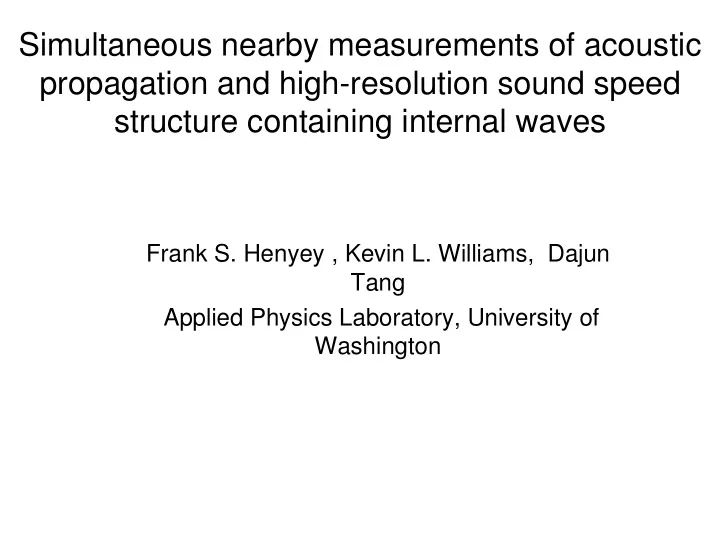

Simultaneous nearby measurements of acoustic propagation and high-resolution sound speed structure containing internal waves Frank S. Henyey , Kevin L. Williams, Dajun Tang Applied Physics Laboratory, University of Washington
Towed CTD chain 48 CTD sensors Nonlinear internal waves (NLIW’s) have a small scale in time and horizontal extent Impractical to move a single CTD fast enough to resolve NLIW Depressor The towed chain has the advantage over a mooring that the wave speed and the slow x - v t evolution was measured in SW06 by repeated passes. Depth, sound speed, and density are extracted from the measurements
GPS Track
Acoustic measurements 2-10 kHz; various pulse types 1 km propagation path Repeated every 20 s Source at 30 m Receivers in clusters near 25 m and 50 m S/N = 45 dB after fm pulse compression
Aug 11 Sound speed extracted from towed CTD data one leg No large waves Note the higher sound speed near bottom -- the sound channel shields acoustic energy from the sediments.
Acoustics on Aug 11 Large fluctuations in intensity The mean field is fit by spreading loss + seawater absorption with random phase modes. The mode cutoff is assumed to be at the bottom critical angle. There is no large random attenuation to explain the fluctuations Not fish. Not Creamer mechanism -- most likely suppressed by the high-c layer near the bottom.
Intensity distribution High-tail cumulative distribution function SI = 1.0 Nearly saturated
Aug 13 400 m (Distances from 73°W, 39°N)
Shoreward leg 1642-1653
Little spice
Seaward leg 1653-1704
Shoreward leg 704-1715
Simple example of interpolation Corrections not needed Interpolation v cos q = 0.6 m / s Ship speed = 3.5 m/s Spacing on shoreward legs = 500 m – 86 m = 414 m Spacing on seaward leg = 300 m + 52 m = 352 m Difference 62 m Distance between legs 400 m Angle between waves 9° Estimate from radar image on Knorr 10°
By such interpolation, the waves on the acoustic path can be reconstructed. The resulting sound speed field can be used in an acoustic propagation Waterfall code. The predicted acoustics can be compared to the measured acoustics Time relative to first arrival (source position uncertain & changing)
With NLIW’s present: Relative times change between no-wave & wave within wave event First arrival scintillates much more Relative intensity changes Arrival time is very sensitive to SSP
Acoustic field with internal solitary wave 2 kHz, absorbing layer at 60 m, source at 30 m QuickTimeª and a decompressor are needed to see this picture.
Summary • Acoustics (at 1 km) depends strongly on water column properties • Scattering by small internal waves studied stochastically • When NLIW’s are in the acoustics path, received signals are dramatically different from those when no NLIW is present • Scattering of sound by NLIWs will be studied deterministically.
Recommend
More recommend